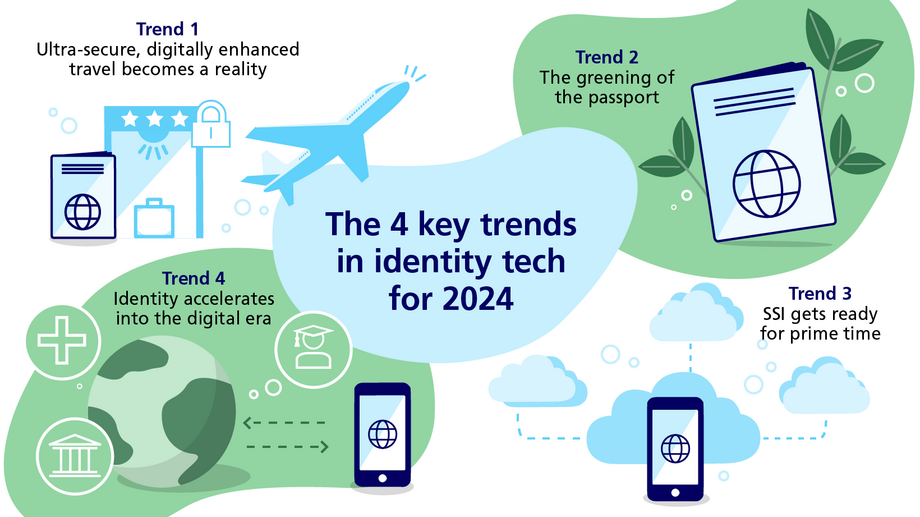As 2024 gets underway, we revisit some of the key identity technology topics and trends covered by G+D Spotlight over the past 12 months and whose impact will only grow in the year ahead.

Four trends in ID tech going mainstream in 2024
In this day and age, our digital identities are as important as our physical ones. Advances in identity tech promise enhanced security, convenience, and access to essential services. From increasingly safe and hassle-free travel, to a smaller carbon footprint and greater individual control over personal data, here are four pivotal trends at the forefront of digital identity.
Trend 1: Ultra-secure, digitally enhanced travel becomes a reality
Imagine a world in which international travel is a reassuring, hassle-free experience no longer involving pre-dawn starts and endless queueing. The good news is that this is a lot closer than ever to becoming a reality as advances in identity technologies make travel safer and less stressful.
Over the past two decades, ePassports storing passenger information and biometric identifiers on microchips have become commonplace, with 1 billion passports currently in circulation.1 The portrait photos used in passports, however, have long been targets for forgers, with morphing software making the challenges of create fake images easier in recent years. That’s becoming a thing of the past: using technologies such as Veridos CLIP ID, it’s now possible to print pictures that are sharp, accurate and durable – and, most importantly, almost impossible to manipulate or forge – directly onto a modern passport’s polycarbonate data page.
Enhanced passport security features not only improve passenger safety – they also enable the use of eKiosks. These eKiosks digitally scan passports and capture biometric data in order to expedite check-in and boarding processes without compromising security. Kiosks such as the VeriCHECK SelfKiosk can complement manual screening booths by pre-registering passenger biometric data in a convenient, streamlined, and GDPR-compliant manner.
And while we’re imagining our ideal travel experience, why not do away with the passport as we know it altogether? Digital Travel Credentials (DTCs) represent the next identity tech frontier, moving beyond physical documents to digital formats that can be stored on personal devices. The DTC system enables passengers to access all necessary travel documentation on their phone, smartwatch, or key fob. This eliminates the need for multiple physical documents – and streamlines verification processes. DTCs also reduce the risk of essential documents getting lost, they are updatable in real time, and can be replaced in a fraction of a second.
Potential use cases aren’t limited to transport hubs, either: DTCs could potentially integrate with local services such as car rentals, hotel check-ins, and digital payments. At the same time, CLIP ID is being extended to ID cards and driver’s licenses, while eKiosks can streamline pre-registration for those same documents.
Trend 2: The greening of the passport
Carbon footprint reduction is a major concern for all industries, but travel and tourism is particularly challenged: the sector is thought to contribute between 8% and 11% of all global emissions.2 As travel has rebounded post-pandemic and consumers become increasingly aware of the importance of sustainable practices, action is needed all-around – by governments, the travel industry, and individuals themselves.
The impact of travel is often hard to quantify, but it is important to take meaningful action in all areas that can be addressed. Industry stakeholders and governments are promoting the use of sustainable materials, manufacturing and transportation practices, and end-of-life disposal for travel documents.
Take the example of ePassports: while the use of polycarbonate to secure passport data pages enables safer travel and more efficient passenger flows, the plastic-based pages do pose some sustainability challenges, notably the sourcing and production of raw materials. What’s more, personal data security needs to be taken into account during the recycling of such passports as the processes are made more complex by their use of composite materials.
Steps are being taken toward reducing the carbon footprint of travel documents by exploring recycled and bio-sourced materials, improving supply chain sustainability, using green energy, and reducing air freight in favor of sea freight. And that is alongside the more ambitious proposition of making such documents all-digital and hosting them on devices such as smartphones and watches (see Trend 1).

Trend 3: Self-sovereign identity gets ready for prime time
The next frontier for identity tech may well be self-sovereign identity (SSI), a revolutionary concept born of the efforts of open-source software communities. This concept proposes to put control over personal data back into the hands of its individual owner.
SSI represents a paradigm shift in how personal identity is managed and utilized in both the digital and physical space. When picking up a rental car, for example, users really only need to prove one thing: that they are legally allowed to drive. While presenting a driver’s license provides a wealth of personal data, including a full name, date of birth, and place of residence, SSI enables individuals to selectively disclose the required piece of information, or verifiable credential (VC), and nothing else. Users can also respond to queries with a simple “yes” or “no” without revealing the underlying personal data that the answer is based on – in a process known as zero-knowledge proof, or ZKP.
SSI shifts control from central identity providers to the individual and helps safeguard against both intrusive data mining and damaging data breaches. But SSI isn’t useful only for people; it also functions as an identifier for digital and mechanical entities, for example in the Internet of Things (IoT) and in machine-to-machine (M2M) communication. So, a smart car might identify itself to an e-charging point, for example, without the owner having to take any action.
Trend 4: Identity accelerates into the digital space
With an estimated 10% of the world population lacking any form of legal identity,3 the United Nations has set an ambitious goal for governments and their tech partners around the world: to establish the legal registration of identity for everyone by 2030.4 And identity leaders such as Veridos are committed to enabling that universal identity registration and management by developing ever-more-innovative ID technology.
Identity enables people to access a wide range of services and rights, including healthcare, education, banking, and democratic participation. And the digitalization of ID helps to extend inclusion by providing access to economic opportunities and services to many unbanked or underbanked individuals. In doing so, it strengthens the integrity of civic processes and enables more efficient delivery of social benefits.
Digital and phygital ID solutions also foster user experiences that are more secure, more sustainable, and more convenient – while contributing to the efficiency of eGovernment processes. Kiosks and biometric personalization tools are speeding identity registration and verification, as well as document capture and renewal processes. And digital identity management is being enhanced even further through the use of artificial Intelligence (AI) for detecting data inconsistencies and attempts at deception.
Added to this, the digitalization of identity is a growing expectation for new generations of consumers who are increasingly accustomed to being able to store essential documents on their mobile devices. In the United States and Canada, in particular, there is growing demand for mobile driver’s licenses (mDLs) – not only as a legal authorization to drive, but also as a primary form of identification. mDLs have applications for identity verification in sectors such as travel, retail, and finance, and also support Know Your Customer / Anti-Money Laundering compliance.

Next steps for ID tech
Digital ID and identity tech are just not a question of improving efficiency but an integral part of a profound, global transformation that is reshaping how individuals, governments, and businesses interact. Challenges persist, including the need for enhanced interoperability between technical infrastructures, regulatory compliance, and user education. But strong collaboration between industry stakeholders, businesses, legal experts, and policymakers could enable digital ID to reach its full potential over the years to come.
Key takeaways
- Passport design innovation and phygital ecosystems can make travel safer and more efficient.
- Sustainability is becoming a significant factor in the design and production of identity documents.
- The digitalization of ID will help to extend legal identity to hundreds of millions of people for the first time, extending access to economic opportunities and public services.
-
ePassport Basics, International Civil Aviation Organization, 2022
-
How sustainable travel documents can help to raise awareness for eco-friendly travel, Veridos, 2023
-
850 million people globally don’t have ID, World Bank Blogs, 2023
-
Take Action for the Sustainable Development Goals, United Nations, 2023
Published: 18/01/2024
Share this article
Subscribe to our newsletter
Don’t miss out on the latest articles in G+D SPOTLIGHT: by subscribing to our newsletter, you’ll be kept up to date on latest trends, ideas, and technical innovations – straight to your inbox every month.


